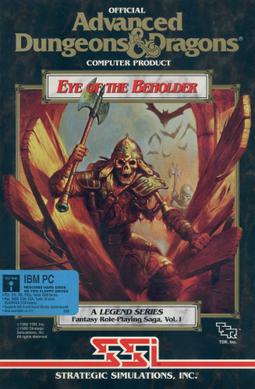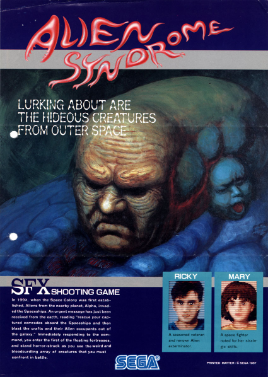
The Sega CD, known as Mega-CD in most regions outside North America and Brazil, is a CD-ROM accessory for the Sega Genesis produced by Sega as part of the fourth generation of video game consoles. It was released on December 12, 1991, in Japan, October 15, 1992, in North America, and April 2, 1993, in Europe. The Sega CD plays CD games and adds hardware functionality such as a faster CPU and graphic enhancements such as sprite scaling and rotation. It can also play audio CDs and CD+G discs.

Phantasy Star is a role-playing video game (RPG) developed by Sega and released for the Master System in 1987. One of the earliest Japanese RPGs for consoles, Phantasy Star tells the story of Alis on her journey to defeat the evil ruler of her star system, King Lassic, after her brother dies at his hands. She traverses between planets, gathering a party of fighters and collecting the items she needs to avenge her brother's death and return peace to the star system. The gameplay features traditional Japanese RPG elements including random encounters and experience points. All the characters have predefined personalities and abilities, a unique element compared to the customizable characters of other RPGs of the era.

Eye of the Beholder is a role-playing video game for personal computers and video game consoles developed by Westwood Associates. It was published by Strategic Simulations, Inc. in 1991, for the MS-DOS operating system and later ported to the Amiga, the Sega CD and the SNES. The Sega CD version features a soundtrack composed by Yuzo Koshiro and Motohiro Kawashima. A port to the Atari Lynx handheld was developed by NuFX in 1993, but was not released. In 2002, an adaptation of the same name was developed by Pronto Games for the Game Boy Advance.
A game programmer is a software engineer, programmer, or computer scientist who primarily develops codebases for video games or related software, such as game development tools. Game programming has many specialized disciplines, all of which fall under the umbrella term of "game programmer". A game programmer should not be confused with a game designer, who works on game design.

Alien Syndrome is a run and gun video game developed by Sega and released in arcades in 1987, and later ported to the Master System in 1988. The game utilizes a side-scrolling feature that allows the player to take control of either a male (Ricky) or female (Mary) soldier whilst hunting aliens and saving hostages before they run out of time.
In the history of video games, the fourth generation of video game consoles, more commonly referred to as the 16-bit era, began on October 30, 1987, with the Japanese release of NEC Home Electronics' PC Engine. Though NEC released the first console of this era, sales were mostly dominated by the rivalry between Sega and Nintendo across most markets: the Sega Mega Drive and the Super Nintendo. Cartridge-based handheld game consoles became prominent during this time, such as the Nintendo Game Boy, Atari Lynx, Sega Game Gear and TurboExpress.

Altered Beast is a 1988 beat 'em up arcade video game developed and published by Sega. The game is set in Ancient Greece and follows a player character chosen by Zeus to rescue his daughter Athena from the demonic ruler of the underworld, Neff. By collecting three power-ups in a level, the player character transforms into one of five magical beasts. It was ported to several home video game consoles and home computers. Altered Beast was the pack-in game when the Genesis launched in North America and the Mega Drive in Europe.

Earthworm Jim 2 is a 1995 run and gun platform video game and the sequel to Earthworm Jim, and the second and final game in the Earthworm Jim series developed by original creators Doug TenNapel, David Perry and Shiny Entertainment. It was released in late 1995 and early 1996 depending on region and video game console, initially being released for the Sega Genesis and Super Nintendo Entertainment System, before being ported to other platforms.

Gunstar Heroes is a run and gun video game developed by Treasure and published by Sega. It was Treasure's debut game, originally released for the Sega Genesis in 1993. The game's premise is centered around a pair of characters, the Gunstars, in their efforts to stop an evil empire from recovering four powerful gems. The characters can fire guns and perform a series of acrobatic maneuvers to fight enemies across each stage. There are four weapons in the game which can be combined with one another to create different shot types.

Virtua Fighter 2 is a 1994 fighting video game developed by Sega. It is the sequel to Virtua Fighter (1993), and the second game in the Virtua Fighter series. It was created by Sega's Yu Suzuki-headed AM2 and was released for arcades in 1994. Ports were released for the Sega Saturn in 1995 and Microsoft Windows in 1997.

Wonder Boy III: The Dragon's Trap, known as Monster World II in Japan, is a platforming action-adventure video game developed by Westone as part of Sega's Wonder Boy series. It was published by Sega and released for the Master System in 1989 and for the Game Gear in 1992 as Wonder Boy: The Dragon's Trap. It was ported by Hudson Soft and released in 1991 for the TurboGrafx-16/PC Engine under the name Dragon's Curse. It was also ported in 1993 by Brazilian company Tec Toy under the title Turma da Mônica em o Resgate, with the game retooled to include characters from Brazilian comic book series Monica's Gang. A remake developed by Lizardcube and published by DotEmu, titled Wonder Boy: The Dragon's Trap, was released in April 2017.

Dead or Alive is a 1996 fighting game by Tecmo and the first entry in Team Ninja's long-running Dead or Alive series. It was released first in arcades in 1996, followed by home ports for the Sega Saturn in Japan during 1997, and later for the PlayStation in all regions during 1998.

Black Dawn is a helicopter-combat simulation, published by Virgin Interactive Entertainment. It was released on the Sony PlayStation and the Sega Saturn in 1996.

Super Monaco GP is a Formula One racing simulation video game released by Sega, originally as a Sega X Board arcade game in 1989, followed by ports for multiple video game consoles and home computers in the early 1990s. It is the sequel to the 1979 arcade game Monaco GP. The arcade game consists of one race, the Monaco Grand Prix, but later ports added more courses and game modes based on the 1989 Formula One World Championship.

Mario & Sonic at the Olympic Winter Games is a 2009 sports and party game developed by Sega. Like its predecessor, it was published by Nintendo for Japan and Korea and by Sega in the Western world. The game is officially licensed by the International Olympic Committee (IOC) through exclusive license International Sports Multimedia. The game is the third official crossover title to feature characters from both Mario and Sonic's respective universes, the first and second being the game's predecessor Mario & Sonic at the Olympic Games and Super Smash Bros. Brawl respectively. It was released on the Wii and the Nintendo DS in October 2009, and is the first official video game of the 2010 Winter Olympic Games.

Arena/Maze of Death, known in Europe as Arena, is an isometric action created by Eden Entertainment Software for the Game Gear. Players have to play the role as a one-person mercenary squad who is trapped in heavily guarded and deadly areas with the primary goal of surviving. This game was released late in the Game Gear's life span. A Master System version was developed simultaneously, but Sega later decided to cancel it in favor of the Game Gear version.

Turbo is a racing game released in arcades in 1981 by Sega. Designed and coded by Steve Hanawa, the game received positive reviews upon release, with praise for its challenging and realistic gameplay, 2.5D color graphics with changing scenery, and cockpit sit-down arcade cabinet. It topped the monthly Play Meter arcade charts in North America and ranking highly on the Game Machine arcade charts in Japan.

Monopoly is a PlayStation video game based on the board game Monopoly, released on November 6, 1997. Developed by Gremlin Interactive and published by Hasbro Interactive, this title was one of many inspired by the property. Despite using the same box art as the 1995 PC version of Monopoly, it is not the same game.

Monopoly is a video game based on the board game Monopoly, released on Game Boy, Genesis, NES, and SNES. Developed by Sculptured Software and published by Parker Brothers, this title was one of many inspired by the property.

Monopoly is a 1999 computer game based on the board game Monopoly, released for Microsoft Windows and Macintosh. Developed by Artech Studios, it was published by Hasbro Interactive, Inc. for Windows and MacSoft for the Mac. This title was one of many inspired by the property-dealing board game. It uses the same box art as a 1998 reissue of the 1995 Monopoly PC game. This game proved to be popular and was re-released as Monopoly New Edition on September 30, 2002, published by Infogrames. The only major difference between this game and its re-release was the absence of the board editor in Monopoly 3. A PlayStation Portable version of this game was released in 2008.

















